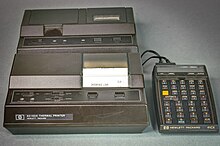 HP-IL connectors (on an HP-71B) | |||
| Type | Peripheral data bus | ||
|---|---|---|---|
| Production history | |||
| Designer | Hewlett-Packard | ||
| Designed | 1980s | ||
| Manufacturer | Hewlett-Packard | ||
| Superseded by | USB (mid-1990s) | ||
| General specifications | |||
| External | yes | ||
| Pins | 2 | ||
| Data | |||
| Data signal | Token ring | ||
| Bitrate |
160 kbit/s (limited to 16 kbit/s) [1] | ||
| Max. devices |
31 (with extensions up to 960) | ||
| Protocol | Serial | ||

The HP-IL (Hewlett-Packard Interface Loop) was a short-range interconnection bus or network introduced by Hewlett-Packard in the early 1980s.[1] It enabled many devices such as printers, plotters, displays, storage devices (floppy disk drives and tape drives), test equipment, etc. to be connected to programmable calculators such as the HP-41C, HP-71B and HP-75C/D, the Series 80 and HP-110 computers, as well as generic ISA bus based PCs.
- ^ *Quick, R.D., Harper, S.L. (January 1983). "HP-IL: A Low-Cost Digital Interface for Portable Applications" (PDF). Hewlett-Packard Journal. 34 (1): 3–10.
{{cite journal}}: CS1 maint: multiple names: authors list (link)